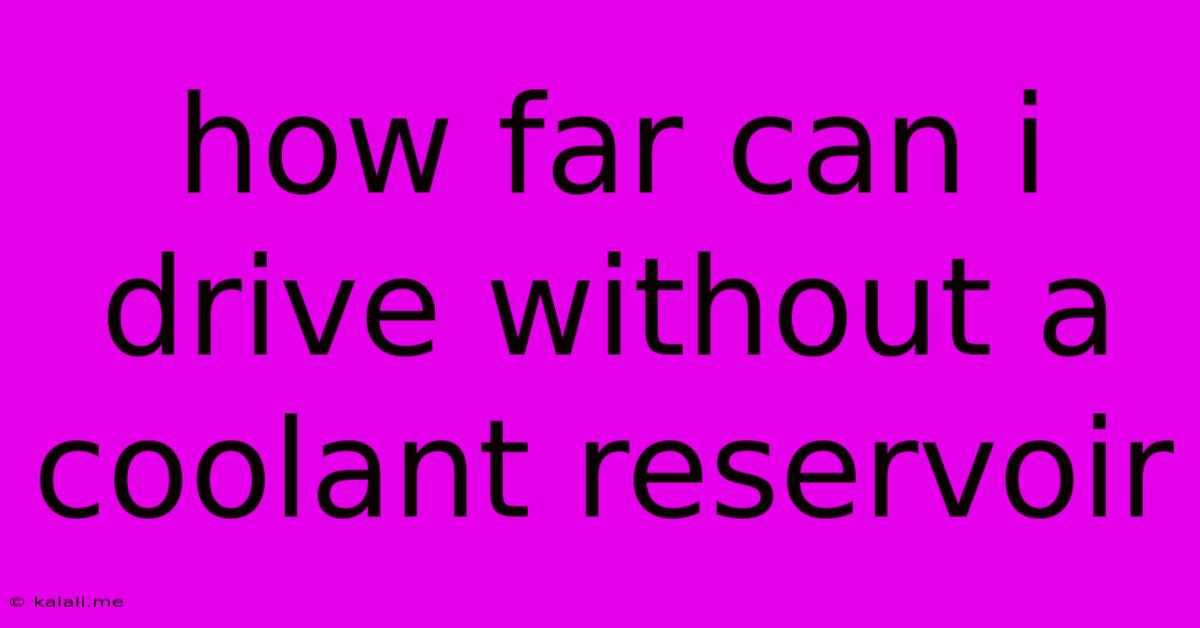How Far Can I Drive Without A Coolant Reservoir
Kalali
Jun 03, 2025 · 3 min read

Table of Contents
How Far Can I Drive Without a Coolant Reservoir? (And What to Do)
Driving with a damaged or missing coolant reservoir is a risky proposition. This article will explore how far you can potentially drive without it, the dangers involved, and the crucial steps to take if you find yourself in this situation. Understanding the role of the coolant reservoir is key to making informed decisions about your driving.
The coolant reservoir, also known as the overflow tank, is a crucial part of your vehicle's cooling system. It acts as a pressure relief valve and storage for excess coolant. When the engine heats up, coolant expands. The reservoir allows for this expansion, preventing pressure buildup that could damage the radiator or engine. Conversely, when the engine cools, the coolant contracts, and the reservoir replenishes the cooling system. Driving without it significantly increases the risk of overheating.
How far can you drive? The honest answer is: not far. You should attempt to get to a safe location as quickly as possible. Even short distances can cause irreparable engine damage. The exact distance depends on several factors, including:
- The ambient temperature: Driving on a hot day will dramatically decrease the distance you can safely drive.
- Driving conditions: Idling in traffic or driving uphill puts more strain on the engine and increases the risk of overheating.
- The condition of your cooling system: If there are other issues in your cooling system, like a leak in the radiator or a failing water pump, the risk of overheating increases exponentially.
The Dangers of Driving Without a Coolant Reservoir:
Driving without a coolant reservoir exposes your engine to severe risks, including:
- Overheating: This is the most immediate and significant danger. Overheating can warp cylinder heads, crack engine blocks, and cause significant internal damage, potentially leading to a costly engine rebuild or replacement.
- Pressure buildup: The lack of a reservoir means that pressure within the cooling system has nowhere to go. This excess pressure can rupture hoses, damage the radiator, or even cause the engine to explode.
- Coolant leaks: Driving without a reservoir can exacerbate existing leaks, making the situation even worse.
What to Do If Your Coolant Reservoir is Damaged or Missing:
- Pull over immediately: Find a safe location to stop, away from traffic. Do not continue driving.
- Turn off the engine: Let the engine cool down completely before attempting any inspection or repair.
- Check the coolant level: If you have a visible coolant leak, determine the extent of the damage and whether it can be temporarily fixed (with caution!).
- Assess the damage: Look for visible cracks or damage to the reservoir or other components of the cooling system.
- Call for assistance: Contact a roadside assistance service or a mechanic to tow your vehicle to a repair shop. Attempting to drive further could cause catastrophic engine damage.
Prevention is Key:
Regular vehicle maintenance, including checking coolant levels and inspecting hoses and other components of the cooling system, is crucial for preventing such situations. Listen for unusual noises or notice any changes in your engine’s performance to address potential issues promptly. A small problem ignored can quickly turn into a major (and expensive) repair.
In conclusion, driving without a coolant reservoir is extremely risky and should be avoided at all costs. Prioritize safety and get your vehicle towed to a repair shop rather than risking further damage to your engine. The cost of repairs after an overheat far outweighs the cost of a simple tow.
Latest Posts
Latest Posts
-
What Does Dmv Temp Visitor Expires 11 14 2018 Mean
Jun 05, 2025
-
Mach 3 2 In Miles Per Hour
Jun 05, 2025
-
One Swallow Doesnt Make A Summer
Jun 05, 2025
-
How To Fix Ac Leak In Car
Jun 05, 2025
-
Is The Dollar Sign Before Or After
Jun 05, 2025
Related Post
Thank you for visiting our website which covers about How Far Can I Drive Without A Coolant Reservoir . We hope the information provided has been useful to you. Feel free to contact us if you have any questions or need further assistance. See you next time and don't miss to bookmark.